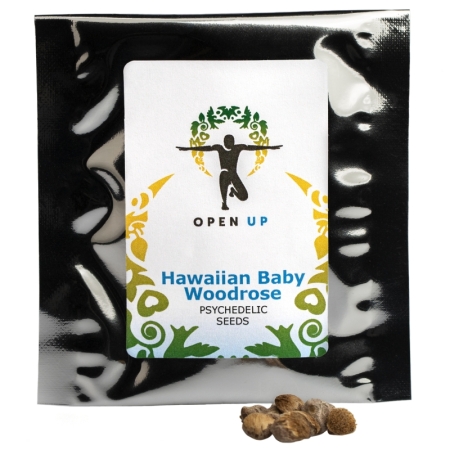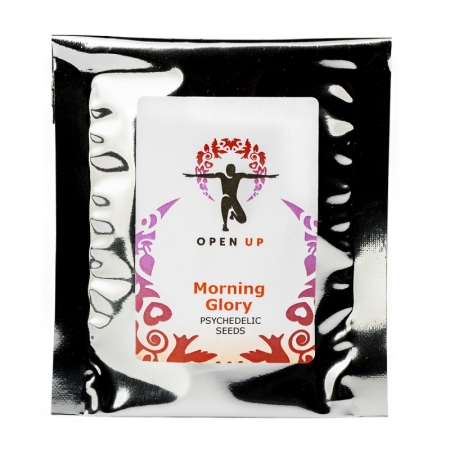Hawaiian Baby Woodrose
Hawaiian Baby Woodrose is a climbing perennial plant. It is native to the Indian subcontinent and has been introduced to various regions of the world including Hawaii, Africa and the Caribbean. Hawaiian Baby Woodrose is well known among psychonauts for its psychedelic, LSD-like effects, which are obtained by the seeds. HBW is a powerful psychedelic, the seed contains the highest concentration of LSA.
Common names for the plant are adhoguda, vidhara, elephant creeper and wooly morning glory. The plant has large, heart-shaped leaves that can grow up to thirty centimetres in diameter. On the top these leaves are smooth and on the underside they have silver hairs. The climbing plant can grow up to 9 meters high and takes quite a long time to get there. The plant grows about thirty centimeters per year. This in contrast to her related sister Morning Glory, also a source of LSA. This climbing plant grows very fast. Just like Morning Glory, Hawaiian Baby Woodrose gets beautiful trumpet-shaped flowers. These can have different colors including different shades of purple, blue and pink. Because of its beautiful appearance the plant likes to be kept in gardens for ornamental purposes. After the flowers are finished flowering, the fruits of the plant appear. These look like small roses of wood (hence the name 'woodrose'). These fruits each contain five to six seeds. The seeds often have a fluffy layer of fungus on the outside, which can be scratched off when one wants to use them for its psychedelic effects.
Botanical name
Argyreia nervosa
History and use of HBW
According to various sources, Hawaiian Baby Woodrose has only recently been used because of its psychedelic properties. In the 60's the plant became known as a cheap and easy to obtain psychedelic. Yet the plant has a long history of medicinal use in India. However, this does not concern the seed, but other parts of the plant, such as the roots. These are used in Ayurvedic medicine to treat rheumatism, among other things. The antioxidants present in the plant, together with the adaptogenic effect, make it widely applicable for various (immunological) disorders. Different parts of the plant are said to have positive properties for the body. Some examples are antitumor, anti-inflammatory, antibacterial. The root of the plant is used in the form of tonic, to purify the body of diseases and toxins. The root of Hawaiian Baby Woodrose is used in Ayurveda for many applications. It is sweet, bitter, appetizing, good for the brain, anti-inflammatory and good for the joints. It is also used for weak nerves. Throughout India the leaves of Hawaiian Baby Woodrose are used as a medicine for various applications. In the form of a bandage, the leaves are applied to wounds and blisters. Hawaiian Baby Woodrose is known to have been used only recently for its psychedelic properties, but has probably been cultivated for centuries, and perhaps thousands of years, because of its medicinal powers known within Ayurveda. There are a number of scientists arguing that HBW might be the mythical, divine plant 'Soma', which can be found in several ancient texts, consisting of the Vedas. These traditional texts in Sanskrit are sacred within Hinduism.
Active constituents
The seed of Hawaiian Baby Woodrose contains several ergoline alkaloids responsible for its psychoactive effects. Examples of active ingredients are ergine, ergometrine, lysergol and lysergic acid. In a study it was shown that the seed of the plant contained 0.325% ergine in dry weight. HBW contains high concentrations of LSA. One seed contains about 0.25 mg LSA, unlike Morning Glory, which contains about 0.01 mg LSA per seed. It should be noted that the concentrations of active ingredients may vary from seed to seed.


How to use Hawaiian Baby Woodrose?
In terms of effects, LSA can be compared to LSD. LSA is a precursor of LSD and has a very similar chemical structure. The differences lie in the fact that LSA is a natural substance, found in different plants. LSD, on the other hand, is a synthetic substance, made by humans.
LSD gives a very clear, mental trip with energy, strong visual and auditory effects, and strongly stimulating. An LSA trip can rather be described as soothing, dreamy (especially in high doses), less stimulating and generally less visual and auditory effects. A dose of LSD is about 1/10 of a dose of LSA.
In addition to LSA, Hawaiian Baby Woodrose contains other active ingredients and plant substances that can cause certain side effects, including mild stomach discomfort, nausea and in some cases vomiting. The substances responsible for these side effects can be found in the skin of the seed. One way to reduce these effects is to consume only the inner part of the seed. Note: the skin of the seed has a very hard structure.
- It is relatively easy to peel the seed.
- Another method is by letting the seed germinate, keeping it moist for a few days (rinsing it several times a day with fresh water) and then eating the inner part.
- What is also done to lose as much as possible of the outer shell of the seed is by burning and scraping off the outer layer.
- Another way to use the seed is to grind it into powder, for example with a coffee grinder or pepper mill. Then the powder can be eaten, made into tea or soaked in cold water.
To minimize nausea, it is recommended to take the seeds on an empty stomach, or at least two hours in advance to eat nothing, and only a light meal.
Microdosing with LSA
Microdosing is becoming increasingly popular nowadays among people who are looking for a way to improve their quality of life in a subtle and effective way. Because of many positive experience stories and various studies, it appears that microdosing with a psychedelic can be beneficial for people with depression, anxiety disorders, cluster headaches and eating disorders, among others. Popular and frequently chosen ways to microdose is with Magic Truffles (1/10 of a normal trip dose).
It is also possible to microdose with LSA. Assuming a standard trip dose between 0.5 and 1.5 mg, or a strong trip dose between 1.5 and 4 mg, a microdose would contain about 0.05 to 0.4 mg LSA. Less is known about microdosing with LSA than with psilocybin, LSD or mescaline, for example.
Also interesting:
"Microdosing with cannabis: All you need to know"
"Microdosing with psilocybin according to the Stamets Stack Formula"
"Microdosing: various psychedelics"
Cultivation of Hawaiian Baby Woodrose
Hawaiia baby woodrose is grown in a greenhouse when the temperature outside can drop below 13 degrees Celsius. In warm areas the plant can be found in pergolas, against walls and winding around trees. Although the name suggests otherwise, this plant did not originally come from Hawaii. It is originally from the Indian subcontinent. HBW can also be found in Australia, China and Malaysia. It is also grown in other parts of the world, mainly through cuttings, or incised seeds. The seeds are incised because of their hard skin, which makes them easy to germinate. She likes humid, sunny locations with nutritious soil the most.
Did you enjoy reading this article and do you like to write yourself? We are always looking for people who share our passion for natural products, who can also translate this into great texts. And we have an interesting reward for this. View all information for writers.











 Nederlands
Nederlands Italiano
Italiano Deutsch
Deutsch Français
Français Português
Português Español
Español Polski
Polski